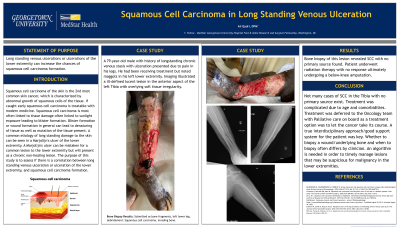Case Series/Study
(CS-123) Squamous Cell Carcinoma Arising from Chronic Venous Ulceration: A Rare but Critical Complication
Friday, May 2, 2025
7:45 PM - 8:45 PM East Coast USA Time

Jordan Young, DPM
Introduction: Long standing venous ulcerations or ulcerations of the lower extremity can increase the chances of squamous cell carcinoma (SCC) formation. SCC of the skin is the 2nd most common skin cancer, which is characterized by abnormal growth of squamous cells of the tissue. If caught early, squamous cell carcinoma is treatable with modern medicine. SCC is most often linked to tissue damage often linked to sunlight exposure leading to blister formation. Blister formation or wound formation in general can lead to denaturing of tissue as well as mutation of the tissue present. A common etiology of long standing damage to the skin can be seen in a Marjolijn's ulcer of the lower extremity. A Marjolijn's ulcer can be mistaken for a common lesion to the lower extremity but will present as a chronic nonhealing lesion. The purpose of this case study is to present a case of SCC in a long standing venous ulceration.
Methods: A 79-year-old male with history of longstanding chronic venous stasis with ulceration presented due to pain in his legs. He had been receiving treatment but noted maggots in his left lower extremity. Imaging illustrated an ill-defined lucent lesion in the anterior aspect of the left Tibia with overlying soft tissue irregularity.
Results: Bone biopsy of this lesion revealed SCC with no primary source found. Patient underwent radiation therapy with no response ultimately undergoing a below-knee amputation.
Discussion: Not many cases of SCC in the Tibia with no primary source exist. Treatment was complicated due to age and comorbidities. Treatment was deferred to the Oncology team with Palliative care on board as a treatment option that was available was to let the cancer take its course. A true interdisciplinary approach/good support system for the patient was key. Whether to biopsy a wound/underlying bone and when to biopsy often differs by clinician. An algorithm is needed in order to timely manage lesions that may be suspicious for malignancy in the lower extremities.
Methods: A 79-year-old male with history of longstanding chronic venous stasis with ulceration presented due to pain in his legs. He had been receiving treatment but noted maggots in his left lower extremity. Imaging illustrated an ill-defined lucent lesion in the anterior aspect of the left Tibia with overlying soft tissue irregularity.
Results: Bone biopsy of this lesion revealed SCC with no primary source found. Patient underwent radiation therapy with no response ultimately undergoing a below-knee amputation.
Discussion: Not many cases of SCC in the Tibia with no primary source exist. Treatment was complicated due to age and comorbidities. Treatment was deferred to the Oncology team with Palliative care on board as a treatment option that was available was to let the cancer take its course. A true interdisciplinary approach/good support system for the patient was key. Whether to biopsy a wound/underlying bone and when to biopsy often differs by clinician. An algorithm is needed in order to timely manage lesions that may be suspicious for malignancy in the lower extremities.

.jpg)